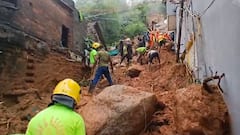Bhubaneswar, Cuttack Roads Flooded After Heavy Rain Lashes Odisha
The weather office reported that the highest rainfall was recorded in Jharsuguda at 118.4 mm, followed by 68.2 mm in Chandbali, and 35.2 mm in Bhubaneswar.

As heavy rain lashed parts of Odisha on Saturday, Bhubaneswar and Cuttack saw widespread waterlogging, causing massive inconvenience for the residents of the cities. India Meteorological Department (IMD) has reported that the state is likely to receive more rainfall this week. The waterlogging in Bhubaneswar led to traffic disruptions and has made driving difficult for the people in knee-deep water. Slums and low-lying areas have been submerged underwater in the capital city.
IMD said that the highest 118.4 mm rainfall was recorded in Jharsuguda, followed by 68.2 mm in Chandbali, 35.2 mm in Bhubaneswar, 13.5 mm in Balasore, 7.2 mm in Puri, 10.6 mm in Sambalpur, and 6 mm in Paradip between 8.30 am and 11.30 am.
Meanwhile, intense rainfall was observed in many areas before 8.30 am. Bhubaneswar and Cuttack recorded 14.7 mm and 41.8 mm of rainfall, respectively by 8.30 am, IMD said. Moderate to intense rainfall is likely in the state capital and Cuttack, according to the weather department. It warned of temporary traffic congestion, slippery roads, and waterlogged roads in low-lying areas of the city. Several Odisha districts are likely to see more rain in the next four to five days, IMD said.
The MeT department of Odisha recorded an average of 10.3 mm of rainfall in the last 24 hours. Between July 1 and 15, the average rainfall was 98.1 mm. The July monthly average is 339.9 mm.
IMD said that a cyclonic circulation is likely to form over the northwest Bay of Bengal around Sunday. Under its influence, a low-pressure area is likely to form over the same region during the subsequent two to three days.
Floods In North India
The northern part of the country, including Delhi, is dealing with massive devastation due to intense rain and floods. On Saturday, Delhi is expected to receive ‘moderate’ rainfall during the day, the weather department said. The national capital is grappling with floods due to the Yamuna flowing above the danger level.
On Friday, IMD issued a 'yellow' alert after predicting moderate rain and thundershowers on Saturday in parts of Delhi, which continues to reel from a flood-like situation. More rain could lead to a rise in the water levels of the Yamuna, which has been flowing above the danger mark of 205.33 metres for days now.
Meanwhile, Himachal Pradesh, which has been devastated by cloudbursts and floods, saw 108 deaths, according to ANI. A fresh warning of more rain till July 18 has been issued by the IMD. There could be heavy to very heavy rainfall in seven districts - Shimla, Sirmaur, Solan, Bilaspur, Mandi, Kullu, and Kangra in the coming 4-5 days. IMD has issued an orange alert for July 15, 16, and 17.
After almost a week of no rain, Mumbai and its suburbs were lashed by heavy rainfall on Friday. which led to waterlogging in some places and resulted in slowing down traffic. It issued the “district forecast and warnings” for the next five days.
In Uttarakhand, the State Disaster Management Authority prepared a flood map after analysing the area using 'Microwave Satellite Data'. The map was sent to the Haridwar district administration, to help them plan and implement relief and rescue operations on time. The satellite images revealed 511 villages have been affected by waterlogging in the district. The State Emergency Operation Center said people in the affected villages of Laksar, Bhagwanpur, Haridwar and Roorkee were being shifted to safer places and food packets, drinking water and relief kits were being distributed to them.
In Haryana and Punjab, the floodwater has started to recede and relief work is being carried out. As the threat of water-borne disease is looming large, medical camps have been set up in flood-hit areas to provide relief to people. At least 39 people have died in rain- and flood-related incidents in Punjab and Haryana.
Trending News
Top Headlines






































